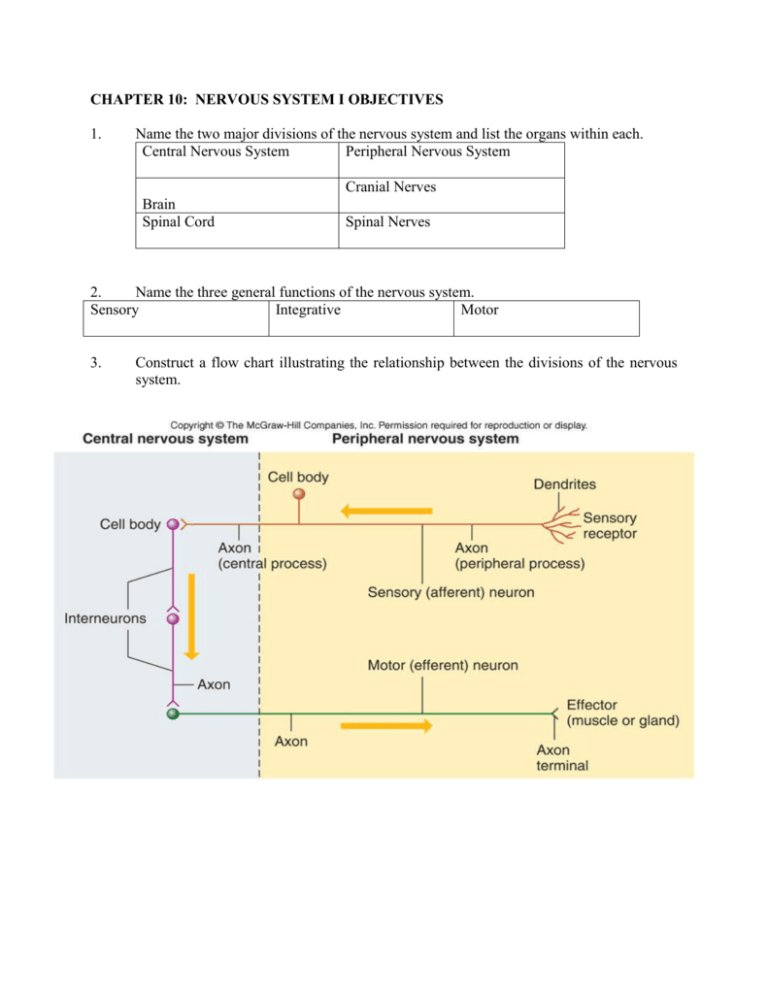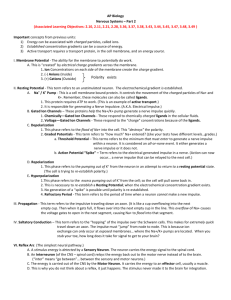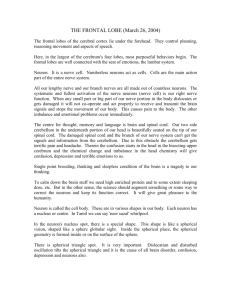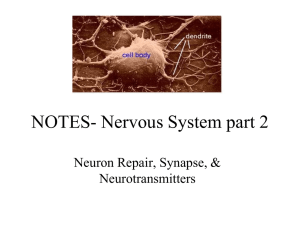CHAPTER 10: NERVOUS SYSTEM I OBJECTIVES 1. Name the two
advertisement

CHAPTER 10: NERVOUS SYSTEM I OBJECTIVES 1. Name the two major divisions of the nervous system and list the organs within each. Central Nervous System Peripheral Nervous System Cranial Nerves Brain Spinal Cord Spinal Nerves 2. Name the three general functions of the nervous system. Sensory Integrative Motor 3. Construct a flow chart illustrating the relationship between the divisions of the nervous system. 4. Distinguish between sensory receptors and effectors. Sensory receptors- specialized structure associated with the peripheral end of a sensory neuron specific to detecting a particular sensation and triggering a nerve impulse in response. Effector = A muscle or gland that effects change in the body. 5. Draw a neuron and label all parts. Neuron Structure 6. Identify Nissl bodies, and explain their function. Rough endoplasmic reticulum = protein synthesis. 7. Identify the receptive portion of a neuron. Dendrites 8. Define the terms myelin sheath, Schwann cell, axonal terminal (synaptic knob), and Node of Ranvier. Myelin sheath- coating around the axon with a higher proportion of lipids than other cell membranes Schwann Cell- Encase the large axons of peripheral neurons (PNS)in lipid rich sheaths Axonal terminal- specialized ending of an axon Node of Ranvier- Narrow gaps in the myelin sheath between Schwann cells. 9. Distinguish between the structure of a small axon and large axon in the PNS. Schwann cells enclose but do not wind around the smallest axons of peripheral neurons,; these axons lack myelin sheaths 10. Distinguish between a Schwann cell and oligodendrocyte. Schwann cells myelinate peripheral axons (A nerve is a bundle of axons in the PNS) Oligodendrocytes myelinate central nervous system axons (White Matter is bundles of myelinated axons in CNS) 11. Describe how cell body damage differs from axonal damage. A damaged axon may allow for regeneration, damage to a cell body = death of an axon 12. Compare and contrast the structure of white matter and gray matter in the CNS. White matter = a bundle of myelinated nerve fibers in the CNS Gray matter = a bundle of cell bodies in CNS. 13. List, and discuss the structure and function of the four types of neuroglial cells in the CNS. Astrocyte- star shaped, nourishes neurons and provide structural support Oligodendrocyte- Looks like an eyeball, produces myelin Microglia- Looks like a spider, Phagocytosis Ependyma, epithelial like layer, lines spaces in the CNS = ventricles, central canal, subarachnoid spaces 14. Define the terms ventricles and central canal (in the CNS). Ventricles- one of four spaces in the brain; ependymal cells line them; CSF fills them. Central Longitudinal canal in the center of spinal cord; continuous with the ventricles of the brain and contains cerebrospinal fluid 15. Classify neurons according to their function. Sensory neurons = afferent neurons (PNS) input impulses into the CNS Interneurons = link neurons; in CMS Motor neurons = efferent neurons (PNS) output impulses from the CNS to responsive body parts called effectors (muscles and glands). 16. N/A 17. Describe the characteristics of a resting membrane. 1. The RMP of a nerve cell is measured to be -70 mV or millivolts (inside / outside). It is established by different concentrations of ions in/out, with high K+ in, high Na+, Cl-, Ca++, out; high negatively charged proteins (A-) in. The RMP is maintained by the Na+K+ATPase pump (active transport). 2. As long as the RMP in a nerve cell is undisturbed, it remains polarized. However, in order for a nerve impulse to be started or propagated in a nerve cell, this resting potential must be disturbed 18. Define the terms potential difference (PD) and resting membrane potential (RMP), and give the numerical value of the RMP in a neuron. Potential Difference (PD) = the difference in electrical charge between 2 points (i.e. across a cell membrane). Resting membrane potential (RMP) of a neuron results from the distribution of ions across the cell membrane RMP of a nerve cell is measured to be -70 mV or millivolts (inside / outside) 19. Describe the process by which the RMP is maintained in a neuron. ion concentrations are maintained by active transport mechanisms mainly the Na+K+ATPase pump 20. Distinguish between hyperpolarization and depolarization and indicate which of these must occur in order to propagate a nerve impulse. The RMP of - 70 mV can be disrupted or changed in one of two directions: 1. more negative = "hyperpolarization" If the MP becomes less negative (i.e. towards zero) = "depolarization" a. The cell membrane of a neuron must be depolarized (to approximately -55mV) in order for certain protein ion channels to open and therefore start a nerve impulse 21. Define the terms threshold potential, action potential, nerve impulse, and repolarization. Threshold potentional-When the resting membrane potential (RMP) of a neuron is depolarized to -55mV Action potential- An action potential represents the start of a nerve impulse in one small portion of the neuron's membrane. = sodium channels opening and sodium ions rushing in. Nerve Impulse- the propagation of action potentials (AP) along a nerve fiber Repolarization- recovery of the RMP to -70mV through opening of potassium channels and potassium ions moving out. 22. List and explain the events involved in the propagation of an action potential in a neuron. RMP of neuron = -70 mV. + 15 mV stimulus (threshold stimulus MP of neuron falls to -55mV = Threshold Potential Na+ channels open (rapid depolarization) Action Potential (nerve impulse*) is produced MP of neuron reaches +30mV = Reversal of MP K+ channels open (repolarization) Na+ channels close RMP of neuron returns to -70mV. 23. Explain how a nerve impulse is transmitted within a neuron. A nerve impulse begins on a dendrite (or cell body of a neuron); runs toward the cell body, through the cell body, and then down the axon and into axonal terminals 24. List and discuss the characteristics of a nerve impulse. All or Nothing Response = if a nerve cell responds at all, it responds completely. a. subthreshold stimulus (5mV) = no AP; no NI b. threshold stimulus (15mV) = yes AP; yes NI c. > threshold stimulus (20mV) = yes AP yes NI, but no greater intensity than above 2.Refractory Period = the period following a NI when a threshold stimulus cannot produce another NI a. The RMP has to be restored before it can be depolarized again (i.e. dominos must be set up in order to be knocked down again) 3. Impulse Conduction = the manner in which the NI runs down the neuron/nerve fiber a. unmyelinated nerve fibers: NI must travel the length of the nerve fiber slow. See Fig 10.18, page 373. b. myelinated nerve fiber: "Saltatory Conduction". NI jumps from node of Ranvier to node of Ranvier Very fast transmission 25. Define the term saltatory conduction. the manner in which the NI runs down the neuron/nerve fiber through myelinated nerve fiber; from Node of Ranvier to Node of Ranvier 26. Define the terms synapse and neurotransmitter (NT), and discuss the steps involved in the synaptic transmission of a nerve impulse from one neuron to another. Synapse = the junctional gap between two neurons where a nerve impulse is transmitted Neurotransmitter- chemicals that an axonal terminal secrete that stimulate/depolarize the dendrite of a second neuron or effector (muscle fiber) 1.NI reaches axonal terminal of pre-synaptic neuron causing depolarization of axonal terminal/synaptic knob’ 2. Ca2+ channels open and calcium ions rush into axonal terminal causing 3. synaptic vesicles (filled with neurotransmitter/NT) to release NT via exocytosis into the synaptic cleft 4. NT diffuses across synaptic cleft and depolarizes the postsynaptic neuron's dendritic membrane. 5. An action potential (AP) is triggered and a NI begins in the post-synaptic neuron 27. Name the most typical neurotransmitter and discuss its function. Most typical NT is Acetylcholine (ACh) a. ACh is released by o all motor neurons (i.e. those that stimulate skeletal muscle) o some CNS neurons. 28. Name two other classes of neurotransmitters and give examples of each. monoamines (modified amino acids) 1. epinephrine 2. norepinephrine 3. dopamine 4. serotonin 5. histamine unmodified amino acids 1. 2. 3. 4. 29. glutamate aspartate GABA (gamma aminobutyric acid) glycine Explain why the NTs discussed above do not continually stimulate the post-synaptic neuron's membrane. Fate of Neurotransmitter in Synaptic Cleft: a. Destruction of Neurotransmitter: Enzymes that are present in the synaptic cleft destroy NT. For example, acetylcholinesterase destroys Ach. b. Reuptake of Neurotransmitter: NT is transported back into axonal terminal/pre-synaptic knob. * Both of the above processes prevent continual stimulation of the post-synaptic membrane! 30. 31. List some typical diseases/disorders that result from NT imbalances. 1. Alzheimer's = deficient ACh 2. Clinical Depression = deficient norepinephrine/ serotonin 3. Epilepsy = Excess GABA leads to excess norepinephrine & dopamine 4. Huntington's Disease = deficient GABA 5. Hypersomnia = excess serotonin 6. Insomnia = deficient serotonin 7. Mania = excess norepinephrine 8. Myasthenia gravis = deficient ACh receptors at NMJ 9. Parkinson's disease = deficient dopamine 10. Schizophrenia = deficient GABA leads to excess dopamine 11. SIDS = excess dopamine 12. Tardive dyskinesia (uncontrollable movements of facial muscles) = deficient dopamine List some drugs that alter neurotransmitter levels. DRUG NT MECHANISM OF AFFECTED ACTION EFFECT Tryptophan Serotonin Stimulates NT synthesis sleepiness Reserpine Norepi packages NT vesicles limb tremors Curare Ach decreases NT in NMJ muscle paralysis Valium GABA enhances receptor binding decreased anxiety Nicotine Ach stimulates synthesis of AChase increased alertness Cocaine Norepi blocks reuptake euphoria Tricyclic Anti depressants Norepi blocks reuptake mood elevation Prozac Serotonin blocks reuptake mood elevation 32. Name the two major neuropeptides in the CNS; discuss why (when) they are released and their effect in the brain and/or spinal cord. enkephalins: a. synthesis is increased during painful stress b. bind to the same receptors in the brain as the narcotic morphine c. relieve pain. Endorphins: same as above, but with a more potent and longer lasting effect








